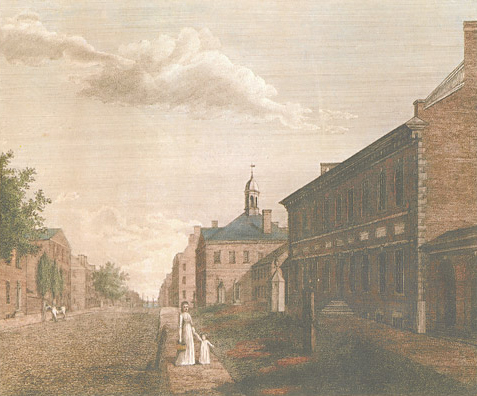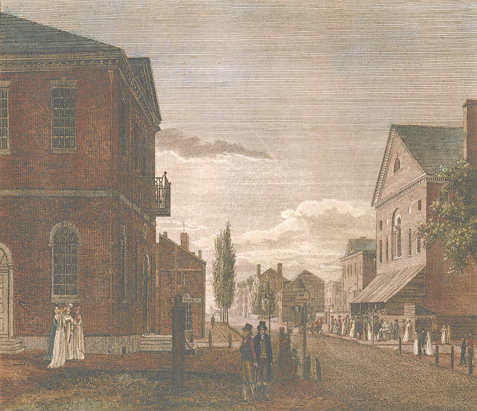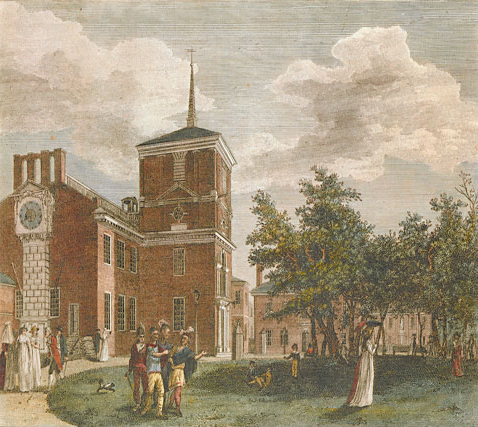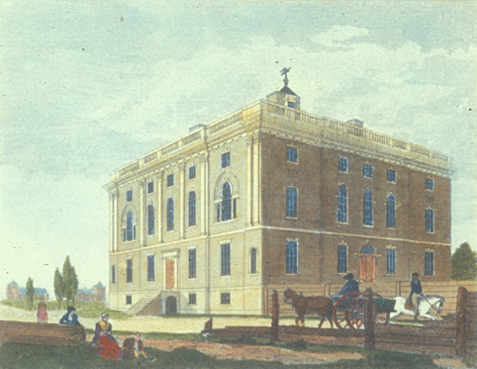Decline
Independence Hall, With a View of Chestnut Street
William Birch
Courtesy Independence Hall National Historic Park
W. R. Birch (17-55–1834), Philadelphia . . . in the Year 1800
Plate 21 is a view in the opposite direction, east down Chestnut Street to ship masts in the Delaware River. Here the main hall is in the right third of the plate with a portion of the arcade connecting to its west wing. The opposite arcade is obscured but the east wing is visible beyond, partially obscuring City Hall, the building with a cupola.
Lewis’s visit to Philadelphia in 1803 came at a time of diminished status for the State House. The national government had moved to Washington and the state government to Lancaster. Old City Hall was no longer occupied by the Supreme Court of the United States. Congress Hall was without Congress. Charles Willson Peale‘s Museum specimens were housed in the State House’s upper floor, in the tower and even in the first-floor Assembly Room where the Declaration of Independence had been approved and signed. By day the State House Yard itself may have been “a sylvan snuggery” enclosed on three sides by a 7-foot brick wall, but it was not a particularly orderly place at night.[1]John L Cotter, Daniel G. Roberts, & Michael Parrington, The Buried Past: An Archaeological History of Philadelphia (Philadelphia: University of Pennsylvania Press, 1992), 106.
The State House tower and wooden steeple, built in 1753 to contain a bell, had weakened to such an extent that removal of the steeple was ordered as early as 1774. It was strong enough for the bell to ring again, but not on July 4th—that was an invention of a 19th century Philadelphia novelist—but with other bells of the city on the evening of July 8th 1776, the day that the Declaration of Independence was read to a crowd in the State House Yard[2]Ellis Oberholtzer, Philadelphia: A History of the City and its People. (Philadelphia: Clarke, 1911), 124. See also Charlene Mires, Independence Hall. (Philadelphia: University of Pennsylvania Press, … Continue reading. When the British marched toward Philadelphia after the American defeat at Brandywine, the bell was spirited away, chiefly to deprive the British of any metal that could be melted down for cannon or other materials of war. The steeple was entirely replaced in 1781, the brick tower roofed and provided with a thin spire and vane, as it appeared in Birch’s plate and as it was available to be seen by Lewis. An approximate reproduction of the earlier steeple was supplied in 1828 and the State House bell returned to the belfry. In the decades before the Civil War, the bell became an anti-slavery symbol; the Abolitionists were the first to call it the “Liberty Bell.”[3]Charlene Mires, Independence Hall in American Memory. (Philadelphia. University of Pennsylvania Press, 2002), 90-91. In 1852 the bell was again removed from the tower and in so doing became very visible, on display in the entry hall of the building until it was removed to new pavilions successively in 1976 and 2003.
Protests
Congress Hall
William Birch
This and the images below courtesy Independence National Historical Park, Karie Diethorn, Chief Curator, and with the kind assistance of library technician Andrea Ashby Leraris.[4]The prints in the INHP collection, which originated in various portfolio sets that preceded Birch’s book, The City of Philadelphia, in the State of Pennsylvania North America, as it appeared in … Continue reading
The main hall of the State House (Independence Hall) fronts on Chestnut Street and is connected by arcades to east and west wings occupied originally by clerical workers. On the same block, but beyond the wings to either side were independent structures, Congress Hall on the west and Old City Hall on the east. Birch’s Plate 20 shows Chestnut Street to the west, just short of its intersection with Sixth Street. Congress Hall occupies the left quarter of this plate.
The tranquility of Birch’s daytime views hardly characterized the disputative climate surrounding the building, then and later. Loyalist against rebel, Federalist against Democratic-Republican—these were simply early participants in a tradition of contentious debate. The yard and surround remained the foci of arguments, demonstrations and vigils, always invoking Independence Hall, its contents and its surround, as the symbol of American democracy. Protest was by no means limited to American national issues. The ground where tourists came to celebrate their liberties became an appropriate place for people of all nationalities to protest repression of civil rights wherever it occurred.
One of the earliest struggles centered on suppressive bills produced during the Adams administration. Congress, while still seated at Philadelphia, issued the Alien and Sedition Acts, the first directed against Jefferson’s presumed sources of support, and the second prohibiting criticism of the President and Congress under threat of imprisonment. Following the election of Jefferson to the Presidency in 1800, the Sedition Act was allowed to lapse and the Alien Act repealed.
Contemporary Issues
In plate 22 the artist has passed through the western arcade to the State House Yard, but continues to face east, now past the main hall and its bell tower. Beyond the trees can be seen the hall of the American Philosophical Society with the label “Museum” on its rear door; it housed Charles Willson Peale’s collections. To the right and across Fifth Street is the Library Company Building and its niched statue of Franklin.
Two 21st-century issues illustrated the symbolic importance of the site. The first, a post-9/11 dilemma, was whether the extensive security arrangements surrounding Independence Hall violated its spirit in the service of protecting its fabric. The second was whether an aspect of national history was being confronted fully. Construction of the newest enshrinement for the Liberty Bell almost literally involved the unearthing of an old contradiction. The site designated for the new pavilion contained the last traces of the President’s House[5]Edward Lawler, “The President’s House in Philadelphia,” Pennsylvania Magazine of History and Biography, vol. 26 (2002), 5-96., the actual[6]Not the large mansion pictured by Birch, which was never occupied by a President, but the house formerly the property of Robert Morris on Market Street. residence of Washington and Adams during their Presidencies, and the quarters of Washington’s nine slaves. The challenge arose that celebration of the concept of liberty, on that piece of ground for that bell, required candid acknowledgment and material representation that it had been occupied simultaneously by one of liberty’s champions and by human beings who were his slaves. A committee jointly representative of the City of Philadelphia and Independence National Historical Park began in September 2005 to decide how that was to be achieved.
Yet at least once the State House and its Yard were brought close to destruction. In need of structures for the new capital in Harrisburg, the state prepared to remove all state buildings on the Square. They were bought instead by the city of Philadelphia in 1818. Still, the full significance of the grounds may not have been realized until 1824-1825, when enthusiastic crowds greeted Lafayette’s extended tour of American cities,[7]Marquis de Lafayette (1757-1834)—he preferred the title of General—came from France as a 19-year-old volunteer, rose to command in many actions, including those at Yorktown, and remained a … Continue reading reviving patriotic sentiments and memories of shared triumphs and dangers. It was only then that the State House was renamed Independence Hall.
Begun by the Commonwealth of Pennsylvania in 1792 as a gift to the nation’s first President, the mansion was still under construction during Washington’s two terms, and his successor, John Adams, declined the honor. When Lewis reached Philadelphia in 1803 to begin preparations for the expedition, the mansion was occupied by the University of Pennsylvania, and it was here that he may have consulted with mathematician Robert Patterson. In the background are the Alms House and House of Employment.
—Joseph Mussulman
Experience the Lewis and Clark Trail
The Lewis and Clark Trail Experience—our sister site at lewisandclark.travel—connects the world to people and places on the Lewis and Clark Trail.
Plan a trip related to Independence Hall (State House):

Notes
| ↑1 | John L Cotter, Daniel G. Roberts, & Michael Parrington, The Buried Past: An Archaeological History of Philadelphia (Philadelphia: University of Pennsylvania Press, 1992), 106. |
|---|---|
| ↑2 | Ellis Oberholtzer, Philadelphia: A History of the City and its People. (Philadelphia: Clarke, 1911), 124. See also Charlene Mires, Independence Hall. (Philadelphia: University of Pennsylvania Press, 2002). |
| ↑3 | Charlene Mires, Independence Hall in American Memory. (Philadelphia. University of Pennsylvania Press, 2002), 90-91. |
| ↑4 | The prints in the INHP collection, which originated in various portfolio sets that preceded Birch’s book, The City of Philadelphia, in the State of Pennsylvania North America, as it appeared in the Year 1800, measure approximately 18 by 14½ inches. |
| ↑5 | Edward Lawler, “The President’s House in Philadelphia,” Pennsylvania Magazine of History and Biography, vol. 26 (2002), 5-96. |
| ↑6 | Not the large mansion pictured by Birch, which was never occupied by a President, but the house formerly the property of Robert Morris on Market Street. |
| ↑7 | Marquis de Lafayette (1757-1834)—he preferred the title of General—came from France as a 19-year-old volunteer, rose to command in many actions, including those at Yorktown, and remained a lifelong friend of Washington and the new American republic. |




